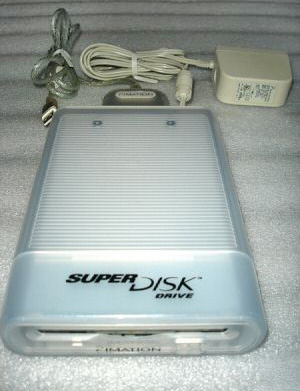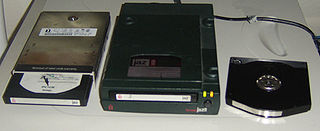Related Research Articles

The SuperDisk LS-120 is a high-speed, high-capacity alternative to the 90 mm (3.5 in), 1.44 MB floppy disk. The SuperDisk hardware was created by 3M's storage products group Imation in 1997, with manufacturing chiefly by Matsushita.

The Zip drive is a removable floppy disk storage system that was announced by Iomega in 1994 and began shipping in March 1995. Considered medium-to-high-capacity at the time of its release, Zip disks were originally launched with capacities of 100 MB, then 250 MB, and finally 750 MB.

A Flash drive is a data storage device that includes flash memory with an integrated USB interface. A typical USB drive is removable, rewritable, and smaller than an optical disc, and usually weighs less than 30 g (1 oz). Since first offered for sale in late 2000, the storage capacities of USB drives range from 8 to 256 gigabytes (GB), 512 GB and 1 terabyte (TB). As of 2023, 2 TB flash drives were the largest currently in production. Some allow up to 100,000 write/erase cycles, depending on the exact type of memory chip used, and are thought to physically last between 10 and 100 years under normal circumstances.
SyQuest Technology, Inc. (Nasdaq: SYQT) was an early entrant into the hard disk drive market for personal computers. The company was founded on January 27, 1982 by Syed Iftikar who had been a founder of Seagate, along with Ben Alaimo, Bill Krajewski, Anil Nigam and George Toldi. Its earliest products were the SQ306R, a 5 MB 3.9" (100 mm) cartridge disk drive and associated Q-Pak cartridge for IBM XT compatibles. Subsequently a non-removable medium version was announced, the SQ306F.

Iomega was a company that produced external, portable, and networked data storage products. Established in the 1980s in Roy, Utah, United States, Iomega sold more than 410 million digital storage drives and disks, including the Zip drive floppy disk system. Formerly a public company, it was acquired by EMC Corporation in 2008, and then by Lenovo, which rebranded the product line as LenovoEMC, until discontinuation in 2018.

REV is a removable hard disk storage system from Iomega.

The Jaz drive is a removable hard disk storage system sold by the Iomega company from 1995 to 2002.

Linear Tape-Open (LTO), also known as LTO Ultrium, is a magnetic tape data storage technology used for backup, data archiving, and data transfer. It was originally developed in the late 1990s as an open standards alternative to the proprietary magnetic tape formats that were available at the time. Upon introduction, LTO rapidly defined the super tape market segment and has consistently been the best-selling super tape format. The latest generation as of 2021, LTO-9, can hold 18 TB in one cartridge.

Travan is an 8 mm magnetic tape cartridge design developed by the 3M company, used for the storage of data in computer backups and mass storage. Over time, subsequent versions of Travan cartridges and drives have been developed that provide greater data capacity, while retaining the standard 8 mm width and 750' length. Travan is standardized under the QIC body. HP Colorado, Iomega DittoMax and AIWA Bolt are proprietary versions of the Travan format.
The PocketZip is a medium-capacity floppy disk storage system that was made by Iomega in 1999 that uses proprietary, small, very thin, 40 MB disks. Its relation to the original Zip drive and disk is the floppy medium and relatively much higher capacity than standard floppy disks. It was known as the "Clik!" drive until the click of death class action lawsuit regarding mass failures of Iomega's Zip drives. Thenceforth, it was renamed to PocketZip. A 100 MB Pocket Zip drive version had been in the works, was intended to be backwards compatible with the 40 MB disks, but ended up being vaporware and PocketZip itself would be discontinued as well.
In computing, external storage refers to non-volatile (secondary) data storage outside a computer's own internal hardware, and thus can be readily disconnected and accessed elsewhere. Such storage devices may refer to removable media, compact flash drives, portable storage devices, or network-attached storage. Web-based cloud storage is the latest technology for external storage.

Travelstar was a brand of 2.5-inch hard disk drive (HDD) that was introduced by IBM in 1994 with the announcement of the Travelstar LP. At 12.5 mm high with two platters, they were available in 360, 540 and 720 MB capacities. Initial models were industry-leading for small form factor HDDs in terms of areal density, data transfer rates and shock tolerance (500g).
In 1953, IBM recognized the immediate application for what it termed a "Random Access File" having high capacity and rapid random access at a relatively low cost. After considering technologies such as wire matrices, rod arrays, drums, drum arrays, etc., the engineers at IBM's San Jose California laboratory invented the hard disk drive. The disk drive created a new level in the computer data hierarchy, then termed Random Access Storage but today known as secondary storage, less expensive and slower than main memory but faster and more expensive than tape drives.

A solid-state drive (SSD) is a solid-state storage device that uses integrated circuit assemblies to store data persistently, typically using flash memory, and functions as secondary storage in the hierarchy of computer storage. It is also sometimes called a semiconductor storage device, a solid-state device, or a solid-state disk, even though SSDs lack the physical spinning disks and movable read-write heads used in hard disk drives (HDDs) and floppy disks. SSD also has rich internal parallelism for data processing.
The host protected area (HPA) is an area of a hard drive or solid-state drive that is not normally visible to an operating system. It was first introduced in the ATA-4 standard CXV (T13) in 2001.

ExcelStor Technology was established in 2000 as a small hard disk drive manufacturer and has evolved into a contract manufacturer and a system integrator. It has a manufacturing plant in Shenzhen, China, and an R&D center in Longmont, Colorado, United States. The company is partly owned by Shenzhen Kaifa Technology, of which the major share holder is China Great Wall Computer Group Co.

The Seagate Barracuda is a series of hard disk drives and later solid state drives produced by Seagate Technology that was first introduced in 1993.
The Opal Storage Specification is a set of specifications for features of data storage devices that enhance their security. For example, it defines a way of encrypting the stored data so that an unauthorized person who gains possession of the device cannot see the data. That is, it is a specification for self-encrypting drives (SED).
ExpressCache is a Windows-based SSD caching technology developed by Condusiv Technologies and licensed to a number of laptop manufacturers including Acer, ASUS, Samsung, Sony, Lenovo, and Fujitsu. ExpressCache is also bundled with some SanDisk products such as ReadyCache; SanDisk currently holds an exclusive ExpressCache license for stand-alone storage products.
References
- ↑ Deichmann, Pete (16 August 2013). "Hack the Dell RD1000 / Imation RDX?" (video). YouTube. Archived from the original on 2021-12-21. Retrieved 24 April 2018.
Dell makes these, Imation mkes one called the RDX. ... The cartridges are interchangeable. ... Inside the cartridge you'll find a standard-looking 2.5-inch laptop hard drive. ... It's got a pair of silicone bumpers that just peel right off. And here we have a Fujitsu 160GB Serial ATA hard drive; appears to be totally standard. ... Either there is some proprietary thing in the way these Fujitsu drive are configured in the BIOS or in the way they are formatted....
- ↑ Lui, Gough (11 December 2016). "Canb2016: Special 2 – iomega REV 35Gb/90Gb Drives & Disks". Dr. Gough's Techzone. Gough Lui. Retrieved 14 April 2018.
A thick metal swing-door front with rubber gasket covers the cartridge opening. The latch is released from the underside to reveal … [photo] … four exposed contacts for driving the spindle motor, a single platter, and a plastic ramp for loading the heads.
- ↑ "Technology Advantages of the RDX ® QuikStor" (PDF). Tandberg Data. Tandberg Data. 2013. Retrieved 14 April 2018.
Inserting a media to a drive is just done via an electronical connection without any physical load of the media like it is done with tape.